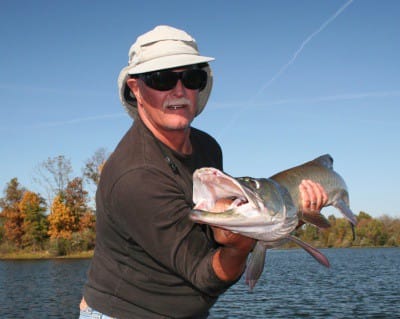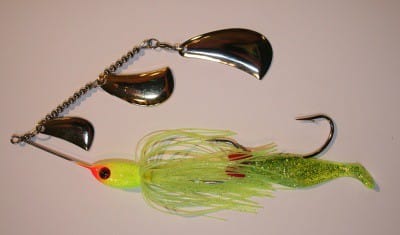
The Native North American tribe Ojibwe used the word maashkinoozhe, meaning “ugly pike,” to describe the muskellunge, or as it’s commonly called the musky. To the fishermen who pursue it, the very name causes an increase in heart rate. A musky fisherman is a breed like no other.
These guys will tell you where they have seen fish, where they have caught fish, even invite you to fish with them – maybe not during a tournament, but after the tournament there are no secrets.
They don’t care how much a fish weighed but rather how long it was. They get as excited when a fish follows their lure as they would landing the fish. Their baits have the coolest names – how could you not love to fish with a lure called the Hogwobbler or a Grandma?
Musky fisherman use specialized gear that is like bass gear on steroids. Even their lingo is different. For example, a bucktail to a lake fisherman is a jig tied with buck tail, whereas to a musky fisherman it is an inline spinner tied with bucktail.
Musky fishing guru Walt Krause knows more about musky than the musky do themselves. In fact, Krause is a musky-catching machine. Krause calls Lake Kincaid, in southern Illinois, his home lake. Kincaid is rated one of the top-10 musky lakes in the United States and Canada.
While many anglers pursue the fish of 10,000 casts without so much as a single fish, Krause averages a fish every three hours. How does he do this?
“By fishing smart – I fish productive water; I don’t spend time fishing where there’s no fish,” said Krause. “Everyone thinks these fish have to feed every day, it’s just not so. The fish will congregate in loose packs. You go in to a bay and let’s say there are 50 fish in this bay. Of these, five fish will be actively feeding. I target these fish and then move to the next bay repeating the process. I don’t spend a lot of time fishing for fish that aren’t feeding.”
In the warmer months Krause targets open water.
“The musky are following the baitfish to open water,” said Krause. “Sure, there will be some fish in the bays still, but you want to concentrate on fish that are actively feeding.”
This philosophy has proven very effective, as Krause and his partner has boated as many as 19 musky on a single day.
Most musky are caught either casting or trolling.
“There are times for casting and times for trolling,” explains Krause. “Most of the year I’m casting. As the water warms up by mid-May on Kincaid, I start trolling, but by mid-June we stop fishing for them all together until mid-September. The warm water causes too much stress on the fish causing Krause to travel north after the northern strain musky. We will troll the first few weeks of September as the fish are in deeper, more open, water and then finish up casting until fall turnover which is another great trolling pattern time to fish.”
Krause is a firm believer in matching the hatch. In early season right after ice out, he might throw a one ounce Rat-LTrap, but points out, “The fish in southern waters like those in Kincaid are much different than musky in northern waters. In northern waters more musky are caught on bucktails than any other bait. In southern waters very few fish are caught on them. As a matter of fact, 75 percent of musky caught in southern lakes are caught on crankbaits, the remaining are taken on spinnerbaits, then live bait and last is the bucktail, a complete 360 degrees from northern musky lakes.”
“Kincaid’s forage fish is shad, especially those in the 5- to 7-inch range. We’ve had folks from up north bring 12-inch suckers down to use as bait, which is a very popular method of catching the northern strain of musky, and they never got a bite. But after they switched to lures that resembled a 7-inch shad, they caught fish,” Krause said.
While on the subject of strains of fish, one thing Krause believes makes southern musky different is the genetics of the southern musky. In the north there is the Wisconsin strain, Leech Lake strain, Great Lakes strain and a few others. In southern waters, the fisheries folk get whatever they can for breeding stock as there is no natural reproduction, which produces a hodge podge of fish, a true Heinz 57 and produces a strain all their own with its own characteristics. In northern waters, a big musky is territorial and seldom leaves the area, whereas in warmer water the musky move a lot.
“In Kincaid, when equipped with transponders the fish were tracked to a single location grouped together and were there for five days and then they dispersed throughout the lake. They just don’t seem to have a home range like they do in the north,” says Krause. “The day we caught 19 musky, they all came off the same hump when we were trolling for walleyes.”

Krause’s Tips to Catch Musky
- “If all else fails throw a white spinnerbait,” advises Krause. “A white spinnerbait will catch fish even when all else fails and it’s easy to use.”
- “Keep a fishing journal; I keep extensive records. If you fish the same body of water, you start noticing some banks will hold fish while others don’t,” says Krause. “I record water temperature, time I caught the fish, water clarity and the lure I caught the fish on. After a few years you will have enough data to be able to look back and say on a day in these conditions they bit a white spinnerbait.” It also helps Krause eliminate non-producing waters or baits. Krause keeps this information on his computer, which makes his research much quicker than writing the information in a paper version.
- “Be prepared to change; one pre-fishing session I caught nine musky, and I just knew I had the tourney. A cold front came in that night and instead of changing like I knew I should have, I went to the same areas I caught my fish in practice and got skunked,” says Krause.
- “If you fish the same, the results will be the same, if you are not catching musky fishing a particular method or bait change one or the other or both,” says Krause. “You have to keep an open mind when fishing. Little things can produce big results. Something as small as a color change can cause a musky to hit bait, remember the fish are shallow, deep or somewhere in between. You’ve got to figure out where they are and how to catch them.”
Parting Words
Krause claims he can’t stress fish-handling safety enough when landing a musky.
“You can’t lip a musky, and the way they thrash around I rarely bring a fish in the boat anymore.” says Krause. “The fish have big lures with huge multiple sets of treble hooks which can get caught in clothing or flesh.”
It is for this reason Krause keeps a hook removal kit in the boat as well as a small set of bolt cutters rather than side cutters due to the diameter of the hooks on a musky lure.
“These bolt cutters can snap right through these hooks, but most side cutters just can’t,” states Krause.
For more information on musky fishing on Lake Kincaid or musky fishing in general contact Krause atwww.waltersguideservice.com
The Union Sportsmen’s Alliance website is designed to provide valuable articles about hunting, fishing and conservation for members of AFL-CIO affiliated labor unions and all sportsmen and sportswomen who appreciate hunting and fishing and want to preserve our outdoor heritage for future generations. If you would like your own story and experience from the outdoors to be considered for our website, please email us atUSAmembers@unionsportsmen.org.



